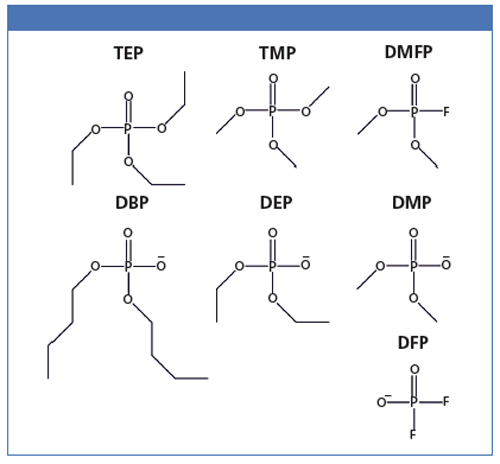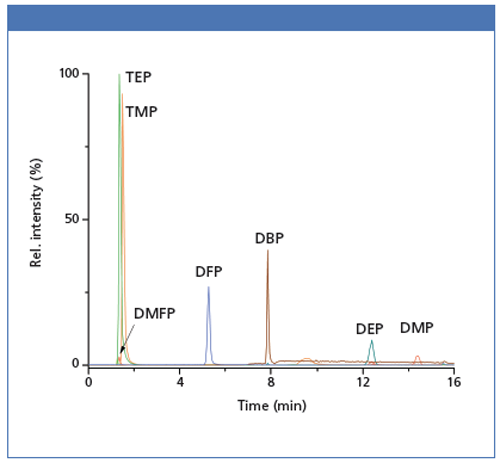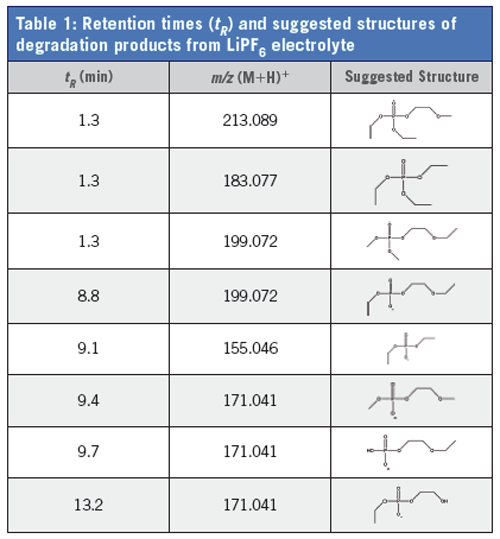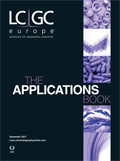Analysis of Organophosphates in Lithium Ion Battery Electrolytes by HILIC–ESI-MS
The Application Notebook
New separation techniques for the analysis of polar and ionic analytes have aroused great interest in the field of metabolomics and environmental investigation in the past two decades. Hydrophilic interaction liquid chromatography (HILIC) is a promising tool to address this challenge. HILIC separation is based on the polarity of analytes, which generally show stronger retention with increasing polarity according to the HILIC separation mechanism. Furthermore, the high content of organic solvent in the mobile phase leads to good ionization properties in the electrospray ionization (ESI), and consequently enhances the detection sensitivity by hyphenated mass spectrometry (MS) detector.
Jonas Henschel1, Martin Winter1,2, Sascha Nowak1, and Wen Jiang3, 1MEET Battery Research Center, University of Münster, 2Forschungszentrum Jülich GmbH, IEK-12, Helmholtz Institute Münster (HI MS), 3HILICON AB
New separation techniques for the analysis of polar and ionic analytes have aroused great interest in the field of metabolomics and environmental investigation in the past two decades. Hydrophilic interaction liquid chromatography (HILIC) is a promising tool to address this challenge. HILIC separation is based on the polarity of analytes, which generally show stronger retention with increasing polarity according to the HILIC separation mechanism. Furthermore, the high content of organic solvent in the mobile phase leads to good ionization properties in the electrospray ionization (ESI), and consequently enhances the detection sensitivity by hyphenated mass spectrometry (MS) detector.
Analysis of organophosphates as the degradation products of pesticides, flame retardants, plasticizers, or batteries is very important for safety evaluation because their chemical structures are similar to chemical warfare agents with high toxic potential (1). Lithium ion batteries possess electrolytes in cells that usually consist of different formulations of linear and cyclic organic carbonates and hexafluorophosphate (LiPF6) conducting salts. One of the major issues is the degradation of LiPF6 as a result of thermal and chemical instability of the P-F bond. Subsequent reactions lead to battery performance loss. The presence of traces of moisture and elevated temperatures in a battery cell promote the decomposition of PF6 to the reactive intermediate PF5 after a reaction cascade culminating in fluorinated and alkylated phosphates (3). Therefore, it is vital to monitor all the organophosphates in batteries, which helps to better understand battery performance loss and to avoid its potential threat to the environment during the disposal process.
Organophosphates cover a wide spectra of ionic and high polar species as well as nonpolar analytes. Multiple separation techniques such as gas chromatography (GC), ion chromatography (IC), or reversed-phase liquid chromatography (LC) are often required for the comprehensive determination of the organophosphates and their formed degradation products (1,2). However, we aimed to develop an LC method using either HILIC or RP column that leads to a simultaneous separation of all organophosphorus species by one chromatography run for our study. In this application, we demonstrate the separation potential of polar and ionic organophosphate species with an iHILIC®-Fusion(+) column packed with charge modulated hydroxyethyl amide silica. A mixed interaction, for example, hydrophilic partitioning and ionic interactions, may be involved in the HILIC separation mechanism depending on the chemical properties of the analytes.
Experimental
LC–MS system 1: Thermo Ultimate 3000 LC system and AB SCIEX 3200 QTrap® equipped with an ESI source, operated in ESI(+) and ESI(-) mode for analysis of standards.
LC–MS system 2: Shimadzu Nexera X2 LC system and Shimadzu LCâMS-IT-TOF™ equipped with an ESI source, operated in ESI(+) mode for analysis of thermally treated battery electrolyte.
Column: 150 × 2.1 mm, 3.5-μm iHILIC®-Fusion(+) (P/N 100.152.0310, HILICON AB)
Gradient elution 1: A) acetonitrile; B) deionized water-1 M ammonium formate, pH 2.9 (99.5:0.5); 0–3.5 min (90:10) A–B; 3.5 to 6.5 min, gradient elution from (90:10) A–B to (50:50) A–B; 6.5–14.5 min, (50:50) A–B.
Gradient elution 2: A) acetonitrile; B) deionized water-1 M ammonium acetate, pH 6.1 (99:1); 0–3.5 min (95:5) A–B; 3.5 to 8 min, gradient elution from (95:5) A–B to (75:25) A–B; 8–16 min, (75:25) A–B.
Flow rate: 0.3 mL/min
Column temperature: 40 °C
Injection volume: 10 µL
Organophosphates: Trimethyl phosphate (TMP), triethyl phosphate (TEP), dimethyl phosphate (DMP), diethyl phosphate (DEP), dibutyl phosphate (DBP), difluorophosphate (DFP), dimethyl fluorophosphates (DMFP). Their detailed chemical structures are illustrated in Figure 1. A 50 µM measure of TMP, TEP, DMP, and DEP, 100 µM of DFP and DBP, and 350 µM of DMFP were prepared in 90:10 acetonitrile–water solution.
Battery electrolyte: 1 M LiPF6 in ethylene carbonate–ethyl methyl carbonate–vinylene carbonate (30:70:+2 w%, LP 572, BASF) with 2v% water addition was stored at 80 °C for 14 days.
Figure 1: Chemical structures of organophosphate standards used in the study.

Results and Conclusion
As shown in Figure 2, seven standards of organophosphates can be simultaneously separated and determined using an iHILIC®âFusion(+) column hyphenated to ESI-MS detection. The nonpolar organophosphates TEP, TMP, and DMFP were eluted first. This is expected due to weaker interaction with the HILIC stationary phase through the hydrophilic partioning. The other four ionic species, DFP, DBP, DEP, and DMP, show stronger retention and good peak shapes by hydrophilic partitioning and ionic interaction.
Figure 2: Extracted ion chromatograms of organophosphate standards in HILIC separation with iHILIC-Fusion(+).

The applicability of the iHILIC®-Fusion(+) column for the study of battery electrolyte degradation products was investigated and is illustrated in Figure 3 and Table 1. The hyphenation of HILIC with an IT-TOFTM-MS system allowed us to separate and elucidate structural information of several formed organophosphates in thermally treated battery electrolyte.
Figure 3: Extracted ion chromatograms of possible degradant organophosphate products in lithium ion battery electrolyte.


This work emphasizes the potential application of using HILIC–ESI-MS methods for the analysis of organophosphates in the battery industry and for environmental investigation.
References
- V. Kraft et al., RSC Advances6, 8–17 (2016).
- I. Van der Veen and J. de Boer, Chemosphere88, 1119–1153 (2012).
- C. Campion et al., J. Electrochem. Soc.152(12), A2327–A2334 (2005).

HILICON AB
Tvistevägen 48, SE-90736 Umeå, Sweden
Tel.: +46 (90) 193469
E-mail: info@hilicon.com
Website: www.hilicon.com

Separation of Ultra-Short and Long Chain PFAS Compounds Using a Positive Charge Surface Column
December 11th 2024A separation of ultra-short and long chain PFAS (C1-C18) is performed on a HALO®PCS Phenyl-Hexyl column along with a HALO®PFAS Delay column which demonstrates excellent retention for both hydrophilic and hydrophobic analytes.






